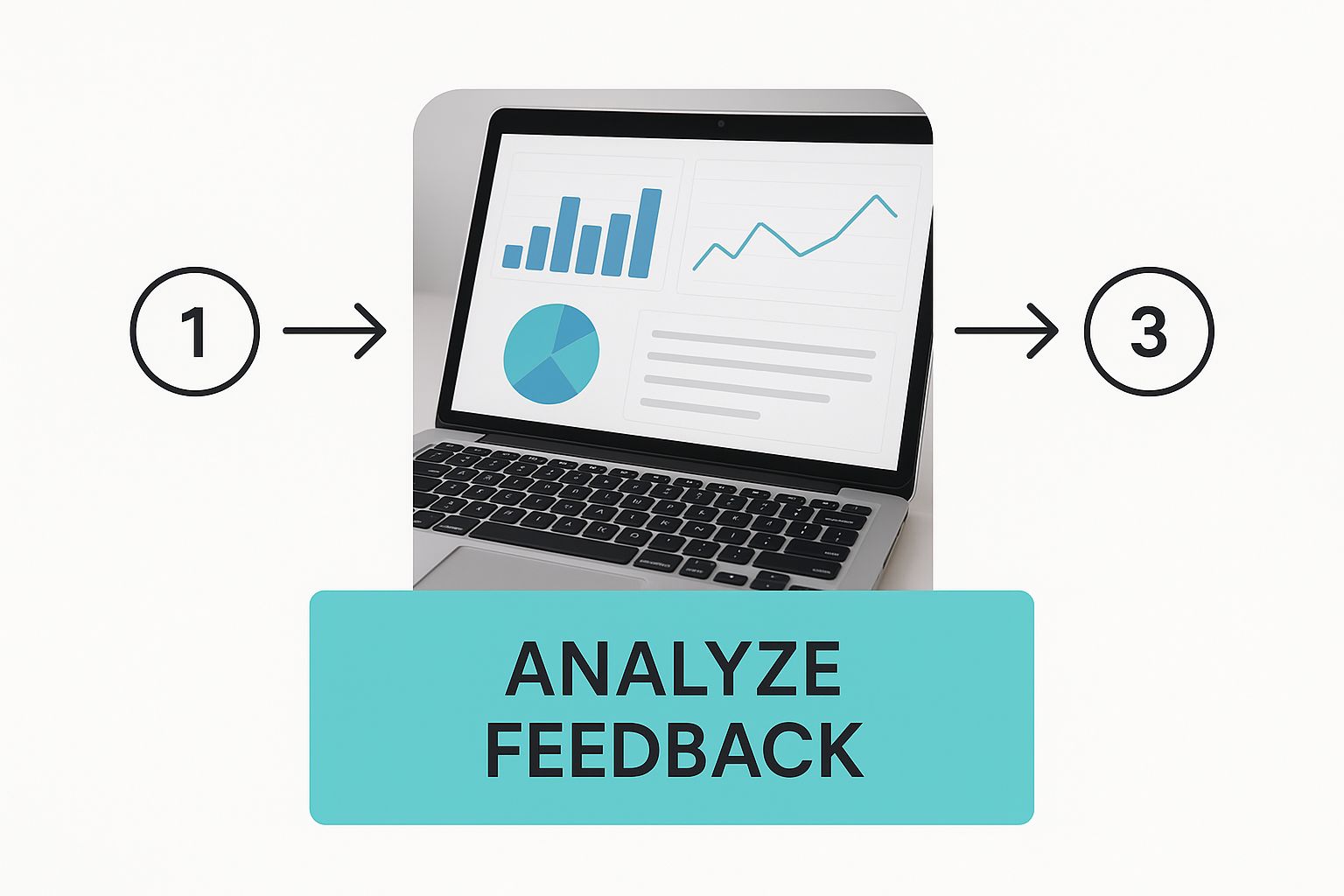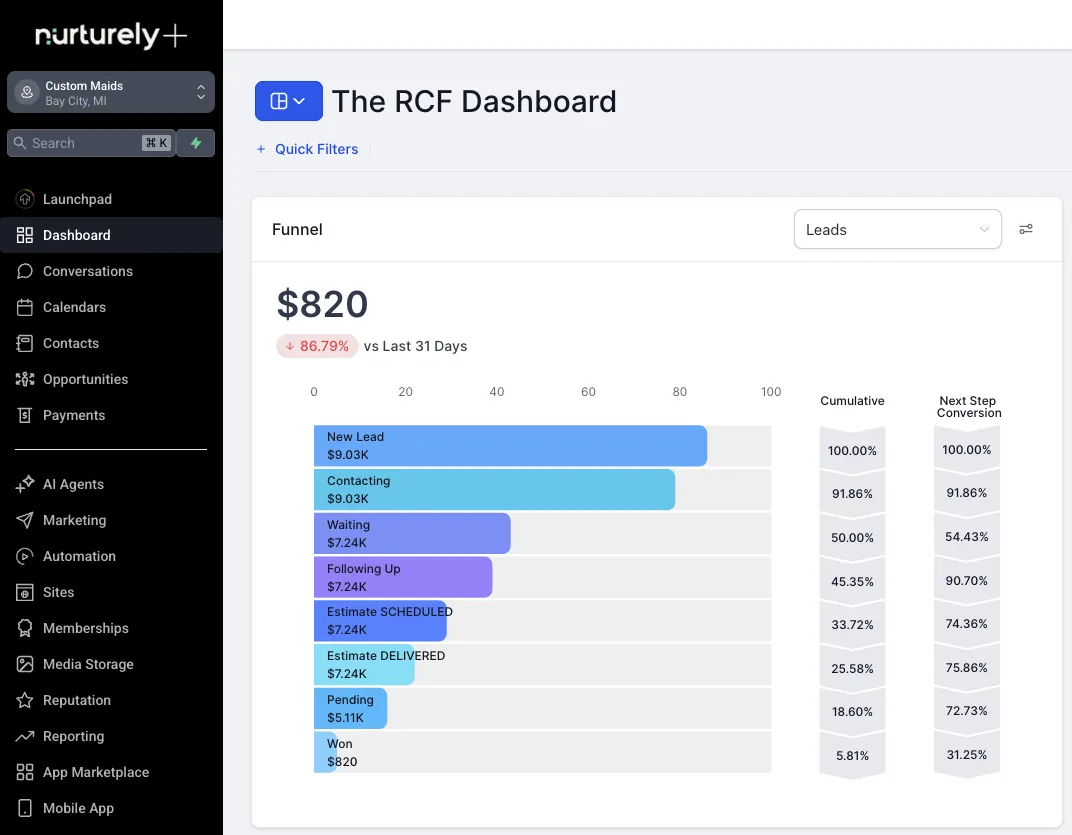How To Master Customer Feedback Management
Master Customer Feedback Management for Business Growth
Ignoring customer feedback isn't just a missed opportunity—it's a direct threat to your bottom line. I've seen it time and time again. When you don't have a system in place for customer feedback management, you're basically letting small problems snowball into major revenue leaks. It’s about turning customer voices into a blueprint for growth, not just damage control.
The Real Cost of Unheard Customer Feedback

So many business owners fall into the "no news is good news" trap. But let's be honest, customer silence is rarely a good sign. It almost always means quiet dissatisfaction that eventually leads to them walking away for good. The financial hit from poor service and ignored feedback isn't just a "what if" scenario; it's a real, measurable drain on your profits.
The numbers are pretty staggering. U.S. companies lose an estimated $75 billion annually just because of poor customer service. That number alone should tell you how high the stakes are. But here's the kicker: even though most businesses know this, there’s a huge gap between knowing and doing. For instance, only about 25% of call centers have truly integrated AI automation, leaving a massive opportunity on the table to actually handle feedback effectively. You can dig into more of these customer service statistics and their impact on businesses to see the full picture.
Key Takeaway: Think of every piece of ignored feedback—a complaint about a late technician, a negative online review—as a crack in your relationship with that customer. Over time, those little cracks widen until you're looking at a serious loss in revenue.
From Minor Complaints to Major Losses
Let’s get specific. Imagine you run a local HVAC company. A single missed call could have been an urgent repair job worth $400. If you had a simple miss-call text-back, you would've captured it. Or what about that one negative online review you never responded to? If that review scares off just five potential customers a month, you could be losing thousands in new installation projects over the course of a year.
These aren't just one-off bad days. They're symptoms of a broken or nonexistent feedback loop. When you don't have a system to capture, analyze, and act on these signals, you're essentially flying blind. This is exactly where a solid customer feedback management strategy becomes your most valuable asset.
Why Proactive Feedback Management Matters
Shifting to a proactive approach means you stop just reacting to problems and start getting ahead of them. It’s about actively seeking out customer opinions, organizing them so they actually make sense, and using those insights to make smarter business decisions.
Look, every business faces similar hurdles when it comes to keeping customers happy. The difference between a struggling business and a thriving one is often how they deal with these common issues.

Putting a system in place transforms these challenges from business-killers into opportunities for improvement. It’s how you build a company that doesn't just survive, but gets stronger with every piece of feedback it receives.
Building Your Feedback Collection Engine
This is where the rubber meets the road. Your entire customer feedback system hinges on one thing: a solid collection engine. Thankfully, Nurturely gives you all the tools you need to build one that captures insights at every critical moment in the customer journey. We’re moving past those tired, one-size-fits-all methods. A modern strategy meets customers wherever they are.
The real goal here is to get the 'silent majority' talking—those customers who wouldn't normally go out of their way to leave a review. And to do that, you need to make giving feedback completely effortless. That means using multiple channels. With Nurturely, you can set up a whole range of feedback touchpoints so your clients barely have to lift a finger.
Setting Up Your Primary Channels
Let's get practical and start with the most impactful moments. You want to ask for feedback when the customer's opinion is freshest and most valuable.
Here are a few ways I’ve seen this work wonders:
Post-Purchase Email Surveys: This is an absolute goldmine for e-commerce. You can set up Nurturely to automatically fire off a simple survey email 24 hours after a product gets delivered. Just ask for a quick star rating and a comment about their purchase. Simple, effective.
Timely SMS Polls: Running an HVAC company? Imagine this: right after your technician completes a service call, an automated text goes out asking, "On a scale of 1-10, how was your service today?" This is how you capture that immediate, in-the-moment feeling when the experience is top of mind.
Embedded Website Forms: If you're a SaaS company rolling out a new feature, you can embed a small feedback form right on that feature's page. This gives you instant, contextual insights without yanking the user out of their workflow.
The most effective feedback strategies are proactive, not passive. You can't just wait for feedback to come to you. You have to go out and ask for it in a way that’s dead simple for the customer.
Building this engine is more critical than ever, especially when you see how customers are changing. The old ways of hearing from people are fading. A major global study recently revealed that only 16% of customers now use social media to complain, and just 22% turn to third-party review sites. That drop makes it incredibly hard to spot problems through public channels, which is exactly why direct, proactive collection is non-negotiable. You can read more about these shifting consumer behaviors from Qualtrics.

Real-World Scenarios and Configurations
Let's look at how this plays out for a couple of real businesses.
I know a residential cleaning company that uses Nurturely's automation to trigger a review request via both email and SMS the second a job is marked "complete" in their CRM. This simple workflow doesn't just gather valuable feedback; it's a powerhouse for online review generation, which is the lifeblood of any local service business. If you want to go deeper on this, check out our guide on how to improve your online review generation.
Here’s another one: a plumbing business uses the Missed-Call Text-Back feature. It not only saves a lost lead but also follows up after the job is done with a quick satisfaction poll. This literally turns a potential negative first impression (a missed call) into a positive, feedback-driven win.
These are just a couple of ideas to get you started. To really build out your feedback engine, I’d also recommend digging into these 10 proven ways to collect customer feedback. By mixing different channels and automating the timing of your requests, you’ll create a powerful system that consistently brings in the insights you need to grow your business.
Automating Your Feedback Analysis and Routing
Getting a steady stream of feedback is a huge win, but let's be honest—it's only half the battle. If all those valuable comments and ratings just pile up in a messy spreadsheet or a crowded inbox, you haven't saved time; you've just created more work. The real power move in modern customer feedback management is making that data work for you automatically.
This is where Nurturely's automation workflows become your secret weapon. Instead of you or your team manually sifting through every single submission, you can set up intelligent rules that do the heavy lifting. This turns a chaotic flood of raw data into an organized, actionable stream of insights. All without the manual burnout.
You can instantly sort feedback based on sentiment—positive, negative, or neutral—and even by specific keywords. This gives you a quick, at-a-glance view of what customers are really talking about, whether it's 'shipping,' a 'bug,' or your 'pricing.'
Setting Up Smart Routing Rules
The real magic happens when you connect these categories to automated actions. This is how you make sure the right information gets to the right people, right when it matters most. To get this right, you really need a solid grasp of your customer touchpoints. If you're looking to go deeper, mastering customer interaction analytics is a great place to start, as it helps turn every conversation into a competitive edge.
Here are a few automation rules you could set up in Nurturely in just a few minutes:
Negative Feedback to Support: Any feedback with a 1- or 2-star rating or containing keywords like 'broken,' 'unhappy,' or 'issue' can automatically create a new ticket in your support queue. Problems get tackled immediately, before they escalate.
Positive Reviews to Marketing: A 5-star review rolls in with glowing words like 'amazing' or 'love it.' The workflow can instantly tag that customer and shoot a notification to your marketing team. Just like that, you’ve flagged a perfect candidate for a future testimonial or case study.
Urgent Issues to Management: You can also create rules for high-priority keywords that you can't afford to miss, like 'legal,' 'safety,' or 'major outage.' This can trigger an immediate email alert straight to a manager’s phone for instant escalation.
This dashboard gives you an idea of how you can visualize the feedback you've collected to spot trends.

It clearly shows where feedback is coming from and the general sentiment, giving you a high-level overview before you dive into the specifics.
Pro Tip: Don't just route feedback—use automation to close the loop. For instance, after a negative review is sent to support and the ticket is closed, you can trigger a follow-up email a week later asking if the customer is now satisfied. It shows you care and that you followed through.
This level of automation is a game-changer for efficiency, and the same principles can supercharge your support systems. To see how, check out our detailed post on how you can automate customer support with similar workflows.
By automating your analysis and routing, you’re not just managing feedback. You're building a responsive, self-improving system that fuels growth across your entire business.
How to Personalize Responses at Scale
Automating your customer responses is a huge time-saver. But let's be honest, it can backfire badly if every single customer gets the same robotic, impersonal reply. A generic message can make someone feel totally ignored—and actually hurt your brand more than sending no response at all.
This is a classic problem in customer feedback management: How do you scale up your communication without sounding like a soulless corporation?
The trick I've found is to blend smart templates with dynamic personalization. In Nurturely, you can build a whole library of response templates to use as a starting point. These aren't one-size-fits-all scripts. Think of them as frameworks that reflect your company's actual personality, whether you're formal and professional or witty and casual.
From there, you inject life into them with custom fields. These are little placeholders that automatically pull in specific customer and job details. It’s the difference between "We received your feedback" and "Hi Jane, thanks for letting us know about your experience with our tech, Mike, on Job #12345." See the difference?
Crafting Your Brand Voice in Templates
Before you even think about writing a template, you need to get crystal clear on your brand's voice. Are you the friendly, helpful neighbor next door? Or are you the polished, buttoned-up expert? There's no right or wrong answer, but you absolutely have to be consistent. The tone of your automated responses should feel like it's coming from the same company as your website and social media posts.
For a more formal brand (like an insurance agency): Your templates would probably use phrases like, "We appreciate you bringing this to our attention," or "Our team will investigate this matter promptly."
For a casual brand (say, a residential cleaning service): You could lean into friendlier language like, "Thanks so much for the feedback!" or "We're so sorry we missed the mark on this one."
This isn't just about being polite; it has a real impact on how people see your business. Research actually shows that businesses using distinct linguistic styles in their online responses build a much stronger reputation. That personal touch is what really fosters satisfaction and gets people talking about you online. You can learn more about how response styles strengthen corporate reputation and customer satisfaction.
My Personal Tip: Don't just make one "positive" and one "negative" template. Get more granular. Create a "Positive Response" and a "Negative Response" template for each main service you offer. For a plumbing company, the way you respond to a leaky faucet complaint needs different details than how you handle feedback on a full boiler installation.
Using Custom Fields for True Personalization
Once you have your base templates dialed in, the custom fields are where the real magic happens. Nurturely’s CRM lets you pop in dynamic tags that make every automated response feel like it was written just for that customer.
Here are a few of the most essential custom fields I always recommend using:
{{contact.first_name}}- The most basic, yet most powerful, tool for personalization. Using someone's name is a game-changer.{{appointment.title}}- This lets you mention the specific service, like "Appliance Repair Visit," which shows you're paying attention.{{user.name}}- Referencing the actual technician or employee involved adds a layer of accountability and personal connection.
When you combine a well-written template with these specific details, you create a system that’s both incredibly efficient and genuinely personal. This approach ensures every single customer interaction reinforces your brand and makes people feel like you're actually listening.
Turning Feedback Into Business Growth

Okay, so you’ve collected feedback, sorted it, and responded. Now for the most important part: turning all that work into real, meaningful business growth.
This is where you close the loop. It’s not about just putting out fires. It’s about using customer insights to build a stronger, more resilient company. When you get this right, customer voices become your single most powerful engine for loyalty and innovation.
Honestly, when you show customers that their feedback was heard and acted on, you build an incredible amount of trust. It’s the difference between a simple data collection exercise and a core part of your business strategy.
Spotting Trends in Your Analytics Dashboard
Your first stop should always be Nurturely’s analytics dashboard. This is where all those individual comments and ratings come together to tell a much bigger story. Instead of getting bogged down in one-off comments, you can zoom out and see the patterns that are actually impacting your customer experience.
Are you noticing a sudden spike in comments mentioning "scheduling confusion"? Or maybe you see a handful of 5-star reviews that all praise a specific technician by name? These aren't just coincidences; they're data points forming a trend. The dashboard makes it visual, so you can quickly tell if something is an isolated issue or a systemic flaw that needs your immediate attention.
A key outcome here is that you give customers fewer reasons to leave. Consistently listening and adapting is a powerful way to reduce churn. For a deeper look at the mechanics, check out this data-driven approach to reduce customer churn.
From Insights to Actionable Change
Once you've nailed down a trend, the real work begins. You have to translate that insight into a concrete action plan. This is where you connect the dots between what your customers are telling you and what your business actually does day-to-day.
Let me give you a few real-world examples of how this plays out:
Product or Service Updates: Let's say you run a cleaning company. If you keep seeing comments about a particular cleaning product leaving a residue, that’s a crystal-clear signal. It’s time to test and switch to a different supplier.
Process Improvements: For an HVAC business, maybe you notice a pattern of feedback pointing to long wait times for non-emergency calls. That’s your cue to rethink your scheduling logic or evaluate your team's capacity planning.
Policy Adjustments: If customers constantly seem confused about your cancellation policy, the problem isn't them—it's the policy. It needs to be simplified or at least communicated much more clearly during the booking process.
These small changes have ripple effects across the entire customer experience. Understanding how all these touchpoints connect is vital, and our guide on https://nurturely.io/post/customer-journey-management offers some great context on that.
Communicating Changes to Close the Loop
This last step is the one most businesses skip, but it’s arguably the most critical: tell your customers what you changed. This single action proves you were listening and validates the time they took to share their thoughts.
You don't need a huge press release. A simple, targeted message works wonders. For instance, you could send an email to your customer list with a subject line like, "You Spoke, We Listened."
In the email, briefly explain the feedback you received and detail the exact change you made to address it. This kind of transparency builds massive goodwill and, believe it or not, encourages people to give you even better, more constructive feedback next time.
Of course! Here is the rewritten section, crafted to match the human-expert style and all specified requirements.
Still Have Questions? Let’s Clear Things Up
Even with a solid plan, you're bound to have some questions floating around as you start building out your own customer feedback management system. It's totally normal. I get these from business owners all the time, so let's tackle some of the most common ones head-on.
How Fast Can I Actually Get This Running with Nurturely?
Honestly? You can have a basic feedback system live in under an hour. I'm not exaggerating. This usually looks like setting up one key collection point—like an automated email survey that goes out after a purchase—and creating a simple rule to organize the responses.
Sure, if you want a more sophisticated, multi-channel setup, that'll take a bit more time to dial in perfectly. But Nurturely was built for speed. The whole point is to get you gathering real, valuable insights almost immediately, not waiting around for weeks or months.
What’s the Most Valuable Type of Feedback to Collect?
The real gold is in feedback that's specific, in-the-moment, and gives you something you can actually do. While scores like NPS or CSAT are decent for a quick pulse check on your overall performance, they don't tell you the whole story. The "why" behind the score is where the magic happens.
My Two Cents: Focus on asking for feedback at pivotal moments in the customer's journey—right after a purchase is made, a support ticket gets closed, or a subscription renews. This gives you context-rich insights you can act on, rather than vague comments that don't help anyone.
Think about it: knowing why a customer gave you a 3-star rating after a service call is infinitely more useful than just knowing the number itself.
How Can I Get More Customers to Actually Leave Feedback?
Getting more people to respond boils down to three things: make it dead simple, ask at the right moment, and prove that you're listening. Ditch the 20-question surveys nobody has time for. Instead, use simple, one-question polls sent via SMS or email to make it effortless.
But the most important part? You have to "close the loop." When you make a change based on what customers have told you, shout it from the rooftops! Send an email, post it on social media. When people see you’re actually paying attention and making changes, they become way more likely to give you their thoughts next time.
What Are the Common Mistakes I Should Avoid?
One of the biggest blunders I see is inconsistency. You can't just ask for feedback once in a blue moon and then let the program collect dust for months. That just signals to your customers that you don't genuinely care. A solid customer feedback management program has to be a consistent, ongoing part of how you operate.
Another classic pitfall is brushing off negative feedback. It’s tempting to want to hide the complaints, but those are often your biggest opportunities in disguise. A quick, transparent response can often turn a frustrated customer into one of your most loyal advocates.
I've put together a quick table to show you how Nurturely's features map directly to the key tasks involved in managing customer feedback. It helps to see how the tools connect to the real-world jobs you need to get done.
Nurturely Feature Set for Feedback Management

As you can see, it's about having an integrated system where each piece works together, from the initial ask all the way to the follow-up.
Ready to turn customer feedback into your biggest growth engine? Nurturely Plus gives you all the tools you need to collect, analyze, and act on customer insights in one simple platform. Start your journey with Nurturely today!



